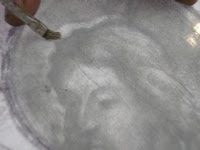
After carefully removing the buckled glass from the church door, a trace is made of the door-light to create a new pattern.

The lead of the old window is cut at the edge and systematically disassembled, attempting to keep from breaking the glass as the pieces are pulled out. This can be difficult depending on the hardness of the original improper cementing.

Replacement glass is obtained and re-cut if necessary, but an attempt is always made to salvage as much original glass as possible. Then the glass is placed on the new pattern.

Finally, it is re-leaded, a relatively simple procedure with straight lines like these. In this case, a bracing bar was also added to the completed window after cementing and cleaning to support the stained glass. We could see from prior experience that the swinging door in which it resides created damage and bowing over time. So now the door-light is better supported by the wooden frame of the door itself, and should prevent future stress and buckling.
 What holds all the glass pieces together in a stained glass window is extruded lead came, which is available in various sizes. Lead is a very soft metal, and to strengthen it, each came is placed in a lead vice like this, and then slightly stretched to harden it. This process is called "tempering" in the metal trades.
What holds all the glass pieces together in a stained glass window is extruded lead came, which is available in various sizes. Lead is a very soft metal, and to strengthen it, each came is placed in a lead vice like this, and then slightly stretched to harden it. This process is called "tempering" in the metal trades.










































 Finally, it is re-leaded, a relatively simple procedure with straight lines like these. In this case, a bracing bar was also added to the completed window after cementing and cleaning to support the stained glass. We could see from prior experience that the swinging door in which it resides created damage and bowing over time. So now the door-light is better supported by the wooden frame of the door itself, and should prevent future stress and buckling.
Finally, it is re-leaded, a relatively simple procedure with straight lines like these. In this case, a bracing bar was also added to the completed window after cementing and cleaning to support the stained glass. We could see from prior experience that the swinging door in which it resides created damage and bowing over time. So now the door-light is better supported by the wooden frame of the door itself, and should prevent future stress and buckling.





